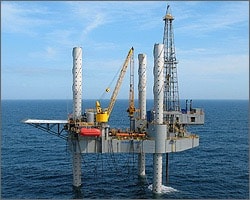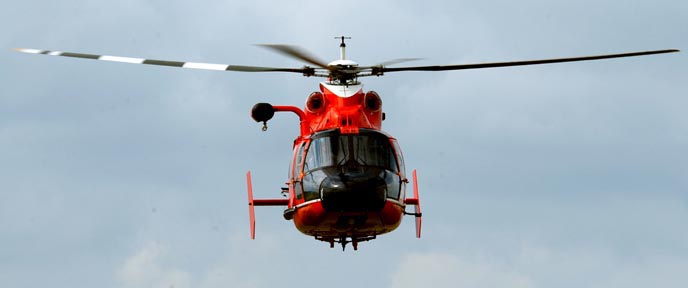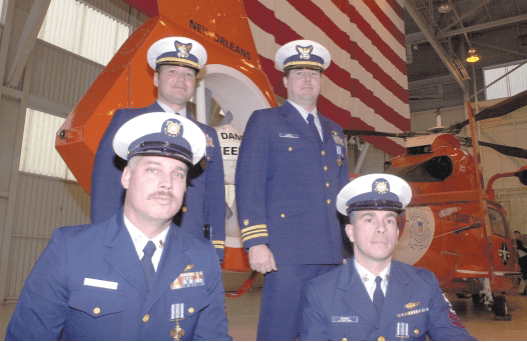Crew of HH65 CGNR 6539
About 10:20 pm on 5 July, 2000, HH-65 CGNR 6539 was heading back to base after monitoring a swamp fire east of Plaquemines Parish, Louisiana and heard “Mayday Mayday Mayday – Ocean Crusader –I’m an oil rig – I’m on fire”
 LCDR Brian Moore, the Aircraft Commander, said “Let’s go! I’ll handle the communications.” LT Troy Beshears, flying the aircraft and in the right seat, turned toward Grand Isle. The radio operator on the rig gave information as to number of people on board and conditions and position. Moore gave Beshears a heading and put the information into the computer. Twenty minutes later, 30 miles south of Grand Isle, they arrived on scene to see flames, fueled by natural gas, shooting from the well head on one side of the jack-up rig. The rescue ladder was blocked by fire. Rescue would be by helicopter evacuation or a jump of 110 feet into the water with marginal survivability. Beshears circled the rig so they could inspect the situation. The pilots and crew then discussed the situation and briefed on what everyone’s job would be as soon as they touched down on the rig. Beshears then started a pattern for a landing on the helicopter pad which jutted out from the rig and was not affected by the fire at this time.
LCDR Brian Moore, the Aircraft Commander, said “Let’s go! I’ll handle the communications.” LT Troy Beshears, flying the aircraft and in the right seat, turned toward Grand Isle. The radio operator on the rig gave information as to number of people on board and conditions and position. Moore gave Beshears a heading and put the information into the computer. Twenty minutes later, 30 miles south of Grand Isle, they arrived on scene to see flames, fueled by natural gas, shooting from the well head on one side of the jack-up rig. The rescue ladder was blocked by fire. Rescue would be by helicopter evacuation or a jump of 110 feet into the water with marginal survivability. Beshears circled the rig so they could inspect the situation. The pilots and crew then discussed the situation and briefed on what everyone’s job would be as soon as they touched down on the rig. Beshears then started a pattern for a landing on the helicopter pad which jutted out from the rig and was not affected by the fire at this time.
At night you do not have the visuals you would have during the daylight. The pad was about 30 by 45 feet. Bouchard hung out the side door estimating forward speed and directing the pilot left or right for touchdown. Beshears said the first thing he saw after landing, was faces and all seemed to jump up at one time. AST1 John Green, the Rescue Swimmer, and AMT1 Michael Bouchard, the hoist operator, kept the rig crew from rushing the helicopter. An evacuation plan was quickly developed: They would fly crew members to another platform about 10 miles away in groups of four which was the maximum capacity for the helicopter. Green stayed on the rig to organize the evacuation. He had hand held radio communication capabilities. Having flown 12 men to safety in three trips the helicopter, low on fuel due to the previous mission had to refuel on the second rig.
During the helicopter trips the oil rig supply ship Madeline McCall came up on the radio and asked if it could be of assistance. Green asked the foreman if there was any way they could get people down to the supply ship. The foreman said that they could try the supply crane which had a net on a ring. A maximum of four men at a time were swung out away from the flames and down to the supply vessel.
 When the helicopter was coming back in Green would return to the flight deck and conduct the evacuation. Green said he felt like an air traffic controller talking and coordinating with helicopter, the supply ship, and people on the rig using his hand held radio.
When the helicopter was coming back in Green would return to the flight deck and conduct the evacuation. Green said he felt like an air traffic controller talking and coordinating with helicopter, the supply ship, and people on the rig using his hand held radio.
With the supply vessel evacuation completed Green planned on the crane operator and himself leaving on the helicopter which would be returning from refueling. At this time they discovered there were two additional people in the rig control room. This would be a problem and Green knew it. They all went to the landing pad. The fire was intensifying because the two men in the control room had shut down the electrical power. Green was relieved when he heard a helicopter coming in. It was a second New Orleans based helicopter and Green vectored it in to the pad. As he feared, with the fuel the helicopter was carrying they could not take all four so green again stayed on the rig to await the return of his helicopter. As the second helicopter left the pad Green could see the lights of his helicopter returning and knew his ride out was a few short minutes away.
Then the rig erupted. “All I saw was fire all the way down to the water, fire a good 100 feet above the top of the rig,” said Beshears. “It looked like a giant mushroom cloud and I thought Oh my God we just lost our swimmer. There was no way there’s anyone alive on that rig.” But there was. The blast had knocked Green flat and he covered his face with his gloved hands.. There had been a flash followed by dense smoke that engulfed the entire rig and amazingly Green had survived. The next thing Beshears and Moore heard was a calm voice over the radio. “If you guys plan on getting me out of here –now would be a good time to do it!”
The crew could see the heavy smoke but not the rig. Moore, as the Aircraft Commander told Green that conditions might require that he jump off the landing pad into the Gulf. Green answered “I jump from 110 feet I am going to break something, be knocked unconscious or something more permanent.” Moore asked him to stand by. Green thought there were no other options but he noticed the helicopter kept getting closer. . Beshears said he was thinking, “If John (Green) jumps he will kill himself – I wanted to give it a try but I knew I might kill the entire crew in the process. It was a hard decision.” I talked it over with Brian (Moore) and he said give it a try but if you do not get a visual on the pad –then wave off” — Beshears continued the pattern flying altitude and headings. He had done it three times before. He knew the location of the landing pad but this time he could not see it and he had no idea what the conditions were at the pad. The next thing he realized they were in dense smoke. Beshears said, “We couldn’t see and we’re flying into something that is solid steel. I figured I had 5 seconds once I entered the smoke and if no visual on the pad I would wave off.” Moore was looking out the left side of the aircraft and Bouchard was hanging out of the aircraft looking for the pad on the right side. Beshears was hoping the rotor downwash would give them vertical visibility. It did and Bouchard spotted the edge of the pad. He called out to Beshears “Left ten feet –easy left” and the wheels of the aircraft touched the pad.
As soon as the helicopter touched it shuddered followed by Bouchard yelling over the intercom, “He’s in he’s in – go, go, go – he’s in. The shudder was Green diving into the helicopter head first and hitting the back bulkhead. Amazingly he was not burned nor injured. Beshears quickly maneuvered the aircraft into a takeoff configuration. The helicopter had not cleared the pad by much when it was rocked by severe force. Beshears said “The whole rig seemed to explode and the force popped us clear on the far side.
They landed at Venice rather than continuing to the Air Station at Belle Chase because of possible damage to the engines. Almost two hours had passed since the crew had heard the distress call. All 51 people were evacuated. No one was injured.
All four Coast Guard aircraft crewmembers were awarded the Distinguished Flying Cross. This is the highest award for aviation heroism in a non-combat situation. As evidenced by this narrative – there should be an award of higher precedence.

Their accomplishments were entered into the Congressional Record by Louisiana Senator Mary Landrieu. The closing paragraph of her tribute is as follows:
Today people say we live in a world without heroes, one in which cynicism and selfishness rule the day. I am proud to say this is not the case in our United States Coast Guard. Guardsmen and Guardswomen like Lieutenant Commander Moore, Lieutenant Beshears, Petty Officer Bouchard and Petty Officer Green put their lives on the line every day so that others may live. In this case, 51 men owe their lives to these four heroes who lived up to the Coast Guard’s motto of “Semper Paratus–Always Prepared.” On behalf of those 51 men, their families, the state of Louisiana and Americans everywhere, I am proud to stand here today and say “Thank you–job well done!” to these extraordinary heroes.
